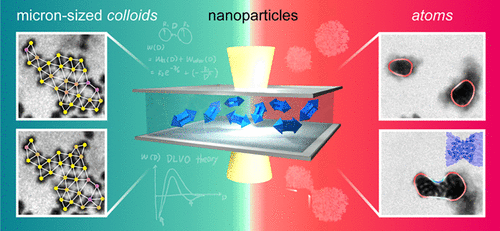当前位置:
X-MOL 学术
›
J. Am. Chem. Soc.
›
论文详情
Our official English website, www.x-mol.net, welcomes your
feedback! (Note: you will need to create a separate account there.)
“Colloid–Atom Duality” in the Assembly Dynamics of Concave Gold Nanoarrows
Journal of the American Chemical Society ( IF 14.4 ) Pub Date : 2020-06-16 , DOI: 10.1021/jacs.0c04444 Chang Liu , Zihao Ou , Fucheng Guo 1 , Binbin Luo , Wenxiang Chen , Limin Qi 1 , Qian Chen
Journal of the American Chemical Society ( IF 14.4 ) Pub Date : 2020-06-16 , DOI: 10.1021/jacs.0c04444 Chang Liu , Zihao Ou , Fucheng Guo 1 , Binbin Luo , Wenxiang Chen , Limin Qi 1 , Qian Chen
Affiliation

|
We use liquid-phase transmission electron microscopy (TEM) to study self-assembly dynamics of charged gold nanoarrows (GNAs), which reveal an unexpected "colloid-atom duality". On one hand, they assemble following the Derjaguin-Landau-Verwey-Overbeek theory for colloids when van der Waals attraction overruns slightly screened electrostatic repulsion. Due to concaveness in shape, GNAs adopt zipper motifs with lateral offset in their assembly matching with our modeling of inter-GNA interaction, which form into unconventional structures resembling degenerate crystal. On the other hand, more screening of electrostatic repulsion leads to merging of clusters assembled from GNAs, reminiscent of the coalescence growth mode in atomic crystals driven by minimization of surface energy, as we measure from the surface fluctuation of clusters. Liquid-phase TEM captures the initial formation of highly curved necks bridging the two clusters. Analysis of the real-time evolution of neck width illustrates the first-time observation of coalescence in colloidal assemblies facilitated by rapid surface diffusion of GNAs. We attribute the duality to the confluence of factors (e.g., nanoscale colloidal interaction, diffusional dynamics) that we access by liquid-phase TEM, taking turns to dominate at different conditions, which is potentially generic to nanoscale. The atom aspect, in particular, can inspire utilization of atomic crystal synthesis strategies to encode structure and dynamics in nanoscale assembly.
中文翻译:

凹面金纳米箭头装配动力学中的“胶体-原子二元性”
我们使用液相透射电子显微镜 (TEM) 来研究带电金纳米箭头 (GNA) 的自组装动力学,这揭示了一种意想不到的“胶体-原子二元性”。一方面,当范德瓦尔斯引力超过轻微屏蔽静电排斥时,它们按照胶体的 Derjaguin-Landau-Verwey-Overbeek 理论组装。由于形状的凹面,GNA 在其装配中采用横向偏移的拉链图案,与我们对 GNA 间相互作用的建模相匹配,形成类似于简并晶体的非常规结构。另一方面,更多的静电排斥屏蔽导致由 GNA 组装的簇的合并,这让人想起由表面能最小化驱动的原子晶体中的聚结生长模式,正如我们从簇的表面波动测量的那样。液相 TEM 捕获了桥接两个簇的高度弯曲颈部的初始形成。对颈部宽度实时演变的分析说明首次观察到 GNA 的快速表面扩散促进了胶体组件的聚结。我们将二元性归因于我们通过液相 TEM 访问的因素(例如,纳米级胶体相互作用、扩散动力学)的汇合,在不同条件下轮流占据主导地位,这可能是纳米级的通用。特别是原子方面,可以激发利用原子晶体合成策略来编码纳米级组装中的结构和动力学。对颈部宽度实时演变的分析说明首次观察到 GNA 的快速表面扩散促进了胶体组件的聚结。我们将二元性归因于我们通过液相 TEM 访问的因素(例如,纳米级胶体相互作用、扩散动力学)的汇合,在不同条件下轮流占据主导地位,这可能是纳米级的通用。特别是原子方面,可以激发利用原子晶体合成策略来编码纳米级组装中的结构和动力学。对颈部宽度实时演变的分析说明首次观察到 GNA 的快速表面扩散促进了胶体组件的聚结。我们将二元性归因于我们通过液相 TEM 访问的因素(例如,纳米级胶体相互作用、扩散动力学)的汇合,在不同条件下轮流占据主导地位,这可能是纳米级的通用。特别是原子方面,可以激发利用原子晶体合成策略来编码纳米级组装中的结构和动力学。这可能是纳米级通用的。特别是原子方面,可以激发利用原子晶体合成策略来编码纳米级组装中的结构和动力学。这可能是纳米级通用的。特别是原子方面,可以激发利用原子晶体合成策略来编码纳米级组装中的结构和动力学。
更新日期:2020-06-16
中文翻译:

凹面金纳米箭头装配动力学中的“胶体-原子二元性”
我们使用液相透射电子显微镜 (TEM) 来研究带电金纳米箭头 (GNA) 的自组装动力学,这揭示了一种意想不到的“胶体-原子二元性”。一方面,当范德瓦尔斯引力超过轻微屏蔽静电排斥时,它们按照胶体的 Derjaguin-Landau-Verwey-Overbeek 理论组装。由于形状的凹面,GNA 在其装配中采用横向偏移的拉链图案,与我们对 GNA 间相互作用的建模相匹配,形成类似于简并晶体的非常规结构。另一方面,更多的静电排斥屏蔽导致由 GNA 组装的簇的合并,这让人想起由表面能最小化驱动的原子晶体中的聚结生长模式,正如我们从簇的表面波动测量的那样。液相 TEM 捕获了桥接两个簇的高度弯曲颈部的初始形成。对颈部宽度实时演变的分析说明首次观察到 GNA 的快速表面扩散促进了胶体组件的聚结。我们将二元性归因于我们通过液相 TEM 访问的因素(例如,纳米级胶体相互作用、扩散动力学)的汇合,在不同条件下轮流占据主导地位,这可能是纳米级的通用。特别是原子方面,可以激发利用原子晶体合成策略来编码纳米级组装中的结构和动力学。对颈部宽度实时演变的分析说明首次观察到 GNA 的快速表面扩散促进了胶体组件的聚结。我们将二元性归因于我们通过液相 TEM 访问的因素(例如,纳米级胶体相互作用、扩散动力学)的汇合,在不同条件下轮流占据主导地位,这可能是纳米级的通用。特别是原子方面,可以激发利用原子晶体合成策略来编码纳米级组装中的结构和动力学。对颈部宽度实时演变的分析说明首次观察到 GNA 的快速表面扩散促进了胶体组件的聚结。我们将二元性归因于我们通过液相 TEM 访问的因素(例如,纳米级胶体相互作用、扩散动力学)的汇合,在不同条件下轮流占据主导地位,这可能是纳米级的通用。特别是原子方面,可以激发利用原子晶体合成策略来编码纳米级组装中的结构和动力学。这可能是纳米级通用的。特别是原子方面,可以激发利用原子晶体合成策略来编码纳米级组装中的结构和动力学。这可能是纳米级通用的。特别是原子方面,可以激发利用原子晶体合成策略来编码纳米级组装中的结构和动力学。











































 京公网安备 11010802027423号
京公网安备 11010802027423号